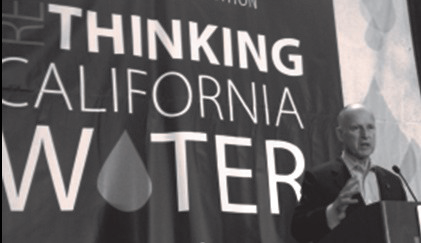BAY-DELTA CONSERVATION PLAN’s 20,000 PAGES
Preliminary Proposal Released
Twenty thousand pages of planning, alternatives and environmental analysis have been released as a preliminary Bay-Delta Conservation Plan (BDCP) draft environmental study. The consultant draft Environmental Impact Report and Environmental Impact Statement (EIR/EIS) is now being examined by Friant Water Authority officials and other water agency leaders.
It provides a preliminary view of potential plan effects of the plan and alternative ways to address water supply reliability and ecosystem restoration in the Sacramento-San Joaquin Delta, BDCP leaders said.
DELTA CONVEYANCE
Delta conveyance is a BDCP focus. Governor Brown’s administration has proposed construction of twin tunnels capable of carrying 9,000 cubic feet per second of Sacramento River water under the Delta to bypass the troubled estuary while still moving water destined for export to pumps near Tracy.
How various “beneficiaries” would fund the costly project has not yet been announced. That issue is of great concern to the Friant Water Authority.
Friant’s primary Delta conveyance concern deals with the U.S. Bureau of Reclamation’s ability to convey Central Valley Project water through the Delta to export pumps for delivery to the San Joaquin River Exchange Contractors. Those four West Side agencies receive a substitute supply of Delta water in exchange for Friant’s diversion of San Joaquin River water for which the Exchange Contractors hold historic rights.
The Exchange Contractors are already “first in line” to receive CVP south-of-the-Delta water. Friant is also interested in opportunities to improve delivery of Cross Valley Water to Friant member districts and whether revised delta operations create or thwart opportunity to recirculation water released from Friant Dam as part of the San Joaquin River Settlement.
ALTERNATIVES ANALYZED
Fifteen action alternatives are analyzed along with one “no action” alternative. The alternatives include a broad combination of water delivery configurations, capacities, operations and habitat restoration targets.
Currently, the “preferred alternative” is a $14 billion plan that would build twin tunnels capable of moving 9,000 cubic feet per second of water through the Delta and restore habitat on more than 100,000 acres.
State and federal officials have announced they intend to release a public review draft of the EIR/EIS October 1, after which a number of workshops and hearings will be scheduled.
The twin tunnels plan has already had its capacity significantly reduced once and a coalition of environmental groups has now proposed further slashing of its capacity to only 3,000 c.f.s. Some environmental community members and Delta interests oppose any such project.
The tunnels are seen as a means of improving California’s water supply reliability by reducing export flows from the estuary in the south delta, improving fishery habitat, and addressing endangered species, water quality, invasive species and infrastructure (particularly fragile levees) problems.
GOVERNOR’S VIEW
Governor Brown on May 8 made an unscheduled appearance at an Association of California Water Agencies conference in Sacramento to say that BDCP adoption would require “all of us working together” and “billions of dollars.”
“We are going to have a reliable water supply,” Brown said. “We have a big project. The federal government is moving along with us. We are going to get there with your help.”
The governor pledged to do “everything humanly possible to get the job done,” referring to the BDCP and its proposed new water conveyance system and ecosystem restoration, ACWA reported.
“We are going to do everything – fix the fish, fix the levees, fix the ponds, the salt going to go out to sea,” Brown said. “The water will flow and everything will work, but it takes a lot of work, billions of dollars, and a lot of back and forth.
“We’ve got real problems, and we have got real solutions,” Brown said. “As long as it takes, I’ll be here to get it done with your help.”
FEDERAL VIEW
“This is an aggressive deadline to issue the environmental analyses for public review and comment that will require a great deal of important work from both our state partners and the [Obama] Administration,” said U.S. Interior Secretary Sally Jewell. “But with California’s water system at constant risk of failure, and the continuing impacts to imperiled fish, we can’t afford the dangers or costs of inaction.”
Brown has asked the Obama administration for “timely” BDCP planning process completion. The Governor said in April that expediting the review was necessary to secure investment from State Water Project and Central Valley Project contractors for the project’s construction.
Officials said administrative BDCP drafts of the environmental documents are preliminary and subject to change.
EARLY PUBLIC REVIEW
Meanwhile, the preliminary BDCP draft continues to be made public. Release of preliminary draft Chapters 8-12 (the final installment of the draft plan) is scheduled for later this month. Draft Chapters 1-7 were released in March and April.
Officials said the preliminary draft BDCP and the corresponding consultant administrative draft EIR/EIS have been posted as informational drafts to give the public ample time for review prior to formal public comment for formal public comment in the fall.
“This is a work in progress,” said California Department of Water Resources Director Mark Cowin. “Releasing these documents early, before the start of a formal public comment period, will help us assess impacts. We will modify the plan wherever possible to minimize disruption, dislocation and any negative impact to Delta residents.”
CONSERVATION PLAN
The BDCP is a habitat conservation plan under state and federal endangered species laws and seeks to achieve two parallel goals — a reversal in the decline of native Delta fish and wildlife populations and a stabilization of water deliveries currently transported through the Delta from the federal and state water projects.

